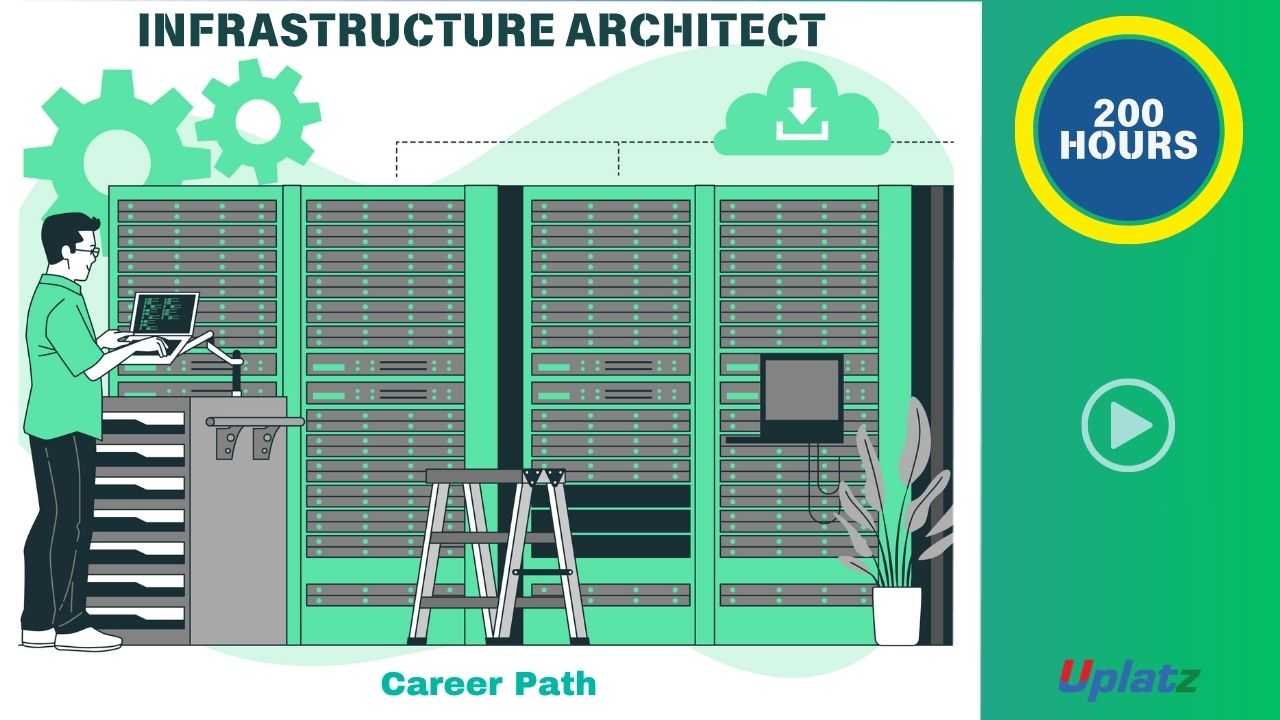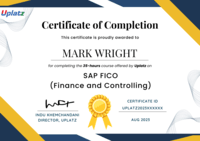Career Path - Infrastructure Architect
Design scalable, secure, resilient IT infrastructure with this comprehensive Infrastructure Architect course. Become Platform Infrastructure Architect Price Match Guarantee
Full Lifetime Access
Access on any Device
Technical Support
Secure Checkout
Course Completion Certificate
Price Match Guarantee
Full Lifetime Access
Access on any Device
Technical Support
Secure Checkout
Course Completion Certificate
 91% Started a new career
BUY THIS COURSE (
91% Started a new career
BUY THIS COURSE (GBP 32 GBP 99 )-
 87% Got a pay increase and promotion
87% Got a pay increase and promotion
Students also bought -
-

- Career Path - Cloud Engineer
- 300 Hours
- GBP 32
- 4412 Learners
-

- Deep Learning: Neural Networks, CNNs, RNNs, NLP, and Deployment
- 45 Hours
- GBP 12
- 4957 Learners
-

- Career Path - Site Reliability Engineer
- 150 Hours
- GBP 32
- 759 Learners

Career Path - Infrastructure Architect – Self-Paced Online Course
The Infrastructure Architect Career Path – Self-Paced Online Course is your gateway to mastering one of the most critical, high-impact roles in the IT industry. Designed for aspiring professionals, experienced system administrators, and IT managers alike, this comprehensive course equips you with the practical knowledge and strategic mindset required to design, implement, and manage complex enterprise IT infrastructures.
As the digital transformation wave accelerates across every sector, organizations increasingly depend on Infrastructure Architects to create secure, scalable, and resilient environments that support business goals. From traditional on-premise setups to cloud-native deployments and hybrid environments, the infrastructure landscape is evolving rapidly. This course prepares you to stay ahead of the curve by teaching both foundational principles and cutting-edge technologies.
You will gain a deep understanding of infrastructure design principles, architectural frameworks, and the full lifecycle of IT infrastructure—from planning and deployment to operations and continuous optimization. Whether your goal is to work in a cloud-first enterprise, a managed services provider, or a large-scale IT department, this course will help you build the confidence and expertise needed to lead infrastructure projects successfully.
What sets this course apart is its self-paced, fully online format, giving you the flexibility to learn on your own schedule, at your own pace. This makes it ideal for working professionals, career switchers, and those balancing multiple responsibilities. All lessons are delivered through high-quality pre-recorded video content, designed and taught by seasoned Infrastructure Architects with years of hands-on industry experience.
What You Will Learn
This course offers a comprehensive exploration of infrastructure architecture, covering everything from legacy systems and data centers to modern cloud-native ecosystems and Infrastructure as Code (IaC). Key focus areas include:
- Enterprise Infrastructure Design: Learn how to create robust architecture blueprints tailored to business and technical needs.
- Cloud and Hybrid Infrastructure: Understand how to design and manage hybrid cloud environments using AWS, Azure, or Google Cloud in combination with on-premise systems.
- Automation and IaC: Get hands-on exposure to automation tools and frameworks such as Terraform, Ansible, and CI/CD pipelines, to manage infrastructure in a scalable, consistent manner.
- Security and Compliance: Incorporate security best practices, governance policies, and compliance standards into your infrastructure design.
- Monitoring and Optimization: Learn how to implement monitoring, logging, and performance tuning strategies for ongoing operational excellence.
Every module is packed with real-world case studies, examples, and architectural diagrams to help you visualize and apply what you’re learning. These lessons are aligned with industry best practices and are relevant across sectors including finance, healthcare, e-commerce, government, and telecommunications.
Who This Course Is For
This course is designed for:
- System Administrators and Network Engineers looking to advance into architecture roles.
- Cloud Engineers and DevOps Professionals who want a broader architectural perspective.
- IT Managers and Team Leads involved in infrastructure projects.
- Career changers with some IT background who aspire to become Infrastructure Architects.
- Students and Graduates of computer science or IT programs who want to specialize in infrastructure design.
Whether you're starting your journey or upskilling to handle more strategic responsibilities, this course will help you establish credibility and prepare for a variety of high-paying infrastructure roles.
How to Use This Course
To maximize the value of this self-paced online course, follow a structured and consistent learning approach:
- Set Your Goals: Begin by identifying your learning goals. Are you looking to transition into a new role? Prepare for certification? Strengthen your knowledge in specific areas? Defining your objectives will help you focus on what matters most.
- Follow the Learning Path: The course is organized into progressive modules that build upon each other. It's best to start at the beginning—even if you have experience—and move sequentially to reinforce your understanding and fill knowledge gaps.
- Take Notes and Reflect: As you go through each lesson, take detailed notes. Summarize key concepts in your own words and think about how you might apply them in real-world scenarios. Reflection helps retention.
- Practice with Tools: When you encounter lessons on tools like Terraform, Ansible, or monitoring platforms, take the time to install and use them in a test environment. Practical experience will greatly enhance your confidence and competence.
- Pause and Revisit: You can rewatch any lesson at any time. If a topic feels complex, pause, research supplementary material if needed, and revisit the video. The flexibility of this format allows for deep learning.
- Engage with Case Studies: Pay close attention to the real-world case studies provided in the course. These examples will help you understand the “why” behind architectural decisions and prepare you for real infrastructure challenges.
- Assess Your Progress: At the end of each module, take time to assess your learning. Some modules may include quizzes or practice questions—use these to check your understanding and reinforce key concepts.
- Apply What You Learn: If you’re currently employed in IT, look for opportunities to apply your new skills in your current job. If not, build personal lab environments or contribute to open-source infrastructure projects to gain hands-on experience.
- Stay Current: Infrastructure architecture is a constantly evolving field. Use the course as a springboard to follow industry blogs, whitepapers, and certification tracks (e.g., AWS Certified Solutions Architect or Azure Solutions Architect Expert).
- Build Your Portfolio: As you complete projects or labs inspired by the course, document your work. Create a portfolio that showcases your skills to potential employers or clients.
The Infrastructure Architect Career Path course is more than just a training program—it's a roadmap to one of the most strategic and future-proof roles in IT. By completing this course, you’ll gain the skills to design and manage scalable, secure, and high-performing infrastructures that support digital transformation initiatives across industries.
Start your journey today, take control of your learning, and unlock a rewarding career as an Infrastructure Architect.
Oops! No Video Subscriptions
By the end of this course, learners will be able to:
- Understand the role of an Infrastructure Architect in enterprise IT
- Design scalable, secure, and highly available infrastructure systems
- Architect hybrid and multi-cloud environments
- Implement Infrastructure as Code (IaC) using tools like Terraform and Ansible
- Lead cloud migration, modernization, and automation projects
- Integrate monitoring, logging, and observability into infrastructure
- Ensure security, compliance, and risk mitigation in infrastructure planning
- Prepare for certifications and leadership roles in infrastructure architecture
Syllabus:
- Introduction to Infrastructure Architecture
- Key responsibilities and principles
- Infrastructure components and lifecycle
- Traditional vs. Modern Infrastructure
- Physical vs. virtual infrastructure
- Private, public, hybrid, and multi-cloud environments
- Cloud Infrastructure Design
- AWS, Azure, GCP infrastructure services
- Designing scalable and resilient cloud systems
- Infrastructure as Code (IaC)
- Introduction to Terraform, Ansible, and automation frameworks
- Scripting and configuration management
- Monitoring, Logging & Observability
- Tools for system health and performance tracking
- Proactive infrastructure operations
- Security and Compliance in Infrastructure
- Network security, access control, encryption
- Compliance standards like HIPAA, GDPR, ISO
- Disaster Recovery and Business Continuity Planning
- Designing for resilience
- Backup strategies and failover architectures
- DevOps and CI/CD Integration
- Infrastructure role in agile and DevOps pipelines
- Site Reliability Engineering (SRE) principles
- Edge, AIOps, and Emerging Trends
- Edge computing, AIOps, and green infrastructure
- Trends shaping the future of IT infrastructure
- Career Roadmap and Certification Guidance
- Resume building and interview prep
- Paths to senior roles and specialized certifications
Upon successful completion of the course, learners will receive a Course Completion Certificate from Uplatz, demonstrating their expertise in infrastructure architecture, cloud environments, and IT modernization.
This Uplatz certification confirms your ability to design and manage complex IT environments, supporting your career growth into senior roles such as Lead Architect, Cloud Architect, or Director of Infrastructure. It also prepares learners for industry-recognized certifications like AWS Certified Solutions Architect, Azure Infrastructure Expert, Google Cloud Architect, HashiCorp Certified: Terraform Associate, and more.
Having this certification can significantly enhance your resume, especially when applying for roles in enterprise IT, cloud computing, or consulting.
Infrastructure Architects are highly valued for their ability to build the foundation of modern IT environments. Their expertise supports business continuity, performance, scalability, and security in mission-critical systems.
Career Paths Include:
- Infrastructure Architect
- Cloud Infrastructure Architect
- Site Reliability Engineer (SRE)
- Systems Architect
- Director of Infrastructure
- Chief Technology Officer (CTO) (long-term)
Industries Hiring Infrastructure Architects:
Banking, finance, telecom, healthcare, retail, e-commerce, SaaS, government, and cloud service providers.
Advancement Opportunities:
- Move into roles like Enterprise Architect or CTO
- Specialize in automation, edge computing, AIOps, or security architecture
- Lead infrastructure teams or run independent consulting practices
With increasing demand and evolving technologies, Infrastructure Architecture offers career security, strong compensation, and ongoing learning opportunities.
1. What is the role of an Infrastructure Architect?
They design, plan, and manage IT infrastructure systems to support performance, availability, and security across enterprise environments.
2. What’s the difference between Infrastructure and Cloud Architecture?
Cloud architecture focuses specifically on cloud-native solutions, while Infrastructure Architecture encompasses all IT environments including on-prem, cloud, and hybrid.
3. What is Infrastructure as Code (IaC)?
IaC is the practice of managing and provisioning infrastructure through machine-readable configuration files instead of manual processes.
4. How do you ensure high availability in infrastructure design?
Through redundancy, load balancing, clustering, and failover systems.
5. What tools are commonly used for infrastructure automation?
Terraform, Ansible, PowerShell, Puppet, Chef, and scripting languages like Python.
6. How do Infrastructure Architects support DevOps?
They design systems that integrate seamlessly into CI/CD pipelines, automate provisioning, and ensure reliable deployment environments.
7. What is a hybrid cloud infrastructure?
A mix of on-premise and public cloud environments designed to balance control, flexibility, and cost.
8. How do you secure an IT infrastructure?
By implementing firewalls, encryption, access control, vulnerability scanning, and compliance with security frameworks.
9. What is edge computing and how does it impact infrastructure?
Edge computing involves processing data closer to the data source, requiring low-latency, decentralized architecture for faster decision-making.
10. What metrics are important in monitoring infrastructure performance?
CPU usage, memory usage, network latency, uptime, error rates, and throughput.









